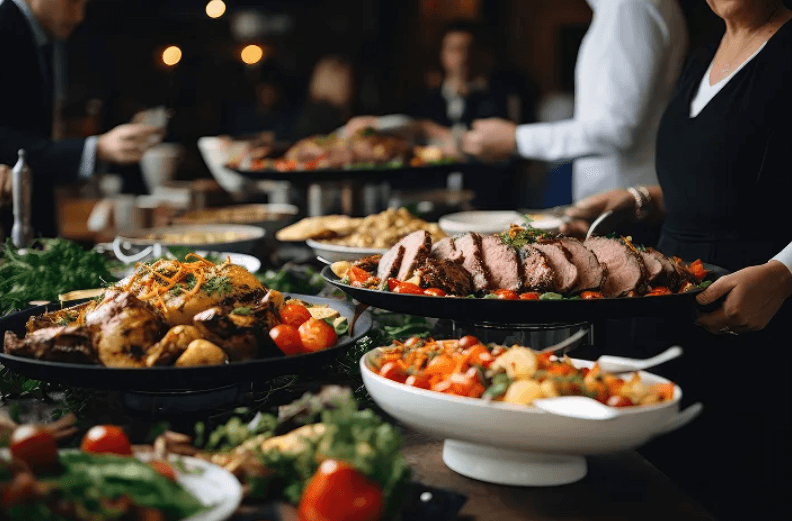
How to Accommodate Catering Dietary Restrictions Without Compromising Flavor
Food is often remembered as one of the most important parts of an event. Guests may forget the speeches or the décor, but they’ll always remember whether the meal was enjoyable. For planners, one of the biggest challenges is creating a menu that accommodates dietary restrictions without sacrificing taste or presentation. With careful planning and the right catering partner, it’s possible to offer meals that feel inclusive, flavorful, and memorable for every guest.
Understanding the Most Common Dietary Restrictions
The first step in designing an accommodating menu is knowing what to expect. Some of the most common dietary restrictions include:
- Gluten-free diets for those with celiac disease or sensitivities.
- Vegan and vegetarian choices for guests who avoid animal products.
- Nut-free meals for those with allergies.
- Dairy-free alternatives for lactose-intolerant guests.
- Low-carb or keto diets that focus on proteins and healthy fats.
- Religious dietary needs, such as halal or kosher meals.
By anticipating a variety of needs, you can create a menu that makes every guest feel considered.
Building a Flexible Menu Framework
A flexible menu is key. Instead of locking into rigid choices, consider offering multiple entrée options, customizable sides, and buffet or family-style service that allows guests to choose what works for them. For example, a salad station with a range of toppings, proteins, and dressings lets people build their own plates while keeping everything fresh and fun.
Buffets and interactive food stations are particularly effective because they naturally allow for variety. Guests who prefer plant-based meals can skip the meat, while others can load their plates with protein. This approach reduces stress for planners and ensures no one feels left out.
See also: Understanding Dystonia: Causes, Symptoms, and Available Treatments
Substitutions That Feel Like Upgrades
The best substitutions don’t feel like compromises. A well-prepared gluten-free pasta made with rice flour or quinoa can be just as satisfying as the traditional version. Dairy-free desserts made with coconut cream or oat milk are not only indulgent but often surprise guests with their rich flavor. By sourcing high-quality alternatives, the event menu can feel elevated rather than restrictive.
Another option is to design naturally inclusive dishes. For example, grilled vegetable skewers, roasted potatoes with fresh herbs, or chickpea curry can appeal to everyone regardless of their dietary needs. Instead of making substitutions feel like a fallback, they become part of the culinary highlight.
Clear and Thoughtful Labeling
Nothing makes a guest more comfortable than clear communication. At buffets or stations, provide tasteful signage that labels dishes as gluten-free, vegan, nut-free, or dairy-free. This helps guests make informed decisions quickly and eliminates the stress of having to ask staff about ingredients. Not only does this enhance the guest experience, but it also helps the event flow smoothly without delays.
Flavor Should Always Come First
Even when accommodating restrictions, flavor must remain the top priority. Fresh herbs, bold spices, seasonal produce, and high-quality proteins can turn any dish into something memorable. Think roasted cauliflower with tahini, citrus-marinated chicken, or a dessert table featuring flourless chocolate cakes alongside fruit tarts. Guests should walk away talking about how delicious the food was, not about what was “missing.”
Going Beyond the Plate: Presentation and Experience
Flavor matters, but so does presentation. Beautifully plated dishes, colorful spreads, and creative serving styles elevate the meal from simple sustenance to a highlight of the event. For example, creating a vegan grazing board with fresh fruits, vegetables, and dairy-free dips can become a centerpiece that sparks conversation.
Experiential touches, such as interactive food stations like build-your-own taco bars, poke bowls, or grain bowls, give guests control while making dietary needs easier to accommodate. Everyone gets a personalized plate that feels intentional and satisfying.
Partner With the Right Caterer
Ultimately, the success of balancing dietary restrictions with flavor comes down to the experience and creativity of the caterer. A seasoned team knows how to prepare menus that delight a wide variety of guests while ensuring safety and inclusivity. Working with professionals like Above & Beyond Catering guarantees that every detail is handled, from planning substitutions to flawless execution on the day of the event.
Their ability to combine imaginative menus with impeccable service ensures that your event dining experience is not only inclusive but also extraordinary. Guests leave feeling cared for, inspired, and fully satisfied.
A Thoughtful Approach Creates Lasting Memories
Accommodating dietary restrictions doesn’t need to feel like an obstacle—it’s an opportunity to show your guests that you care about them. By focusing on flexible menus, thoughtful substitutions, clear communication, and flavor-forward recipes, you can design meals that everyone enjoys. With the right catering partner by your side, inclusivity becomes effortless, and your event dining experience leaves a lasting impression on every guest.




